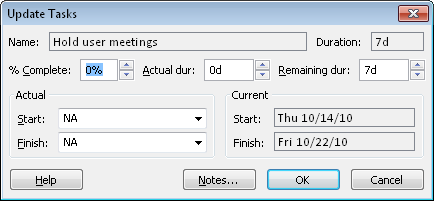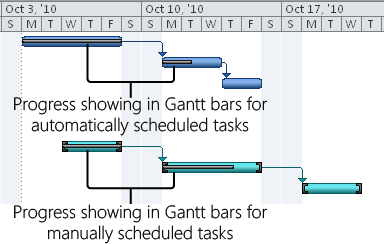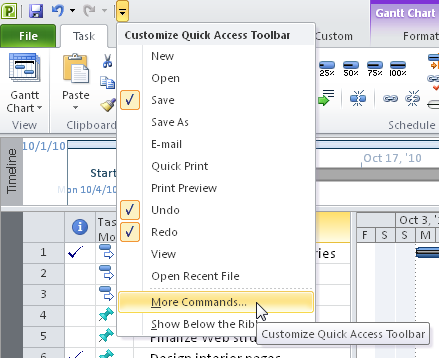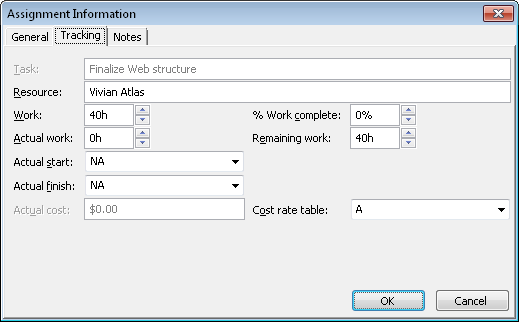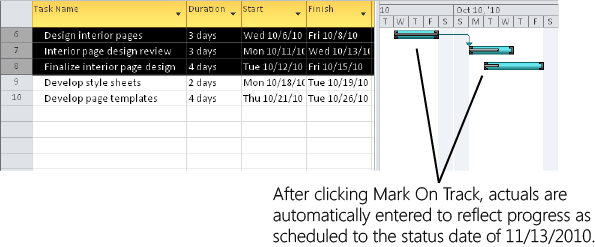So the resources are digging into their assignments, and progress is being made. At regular intervals, you want to record their progress in Project 2010. Depending on how much time you want to spend entering progress information (and how much time you want your team members to spend doing that) and how much detail you or your client need, you can choose a simple, high-level method; a comprehensive, detailed method; or something in between.
Entering actual progress information in Project 2010 ensures that you always know how the project is going. You can keep an eye on the critical path and your budget. You can monitor key tasks and know exactly when you’ll be handing off an important deliverable. With actual information coming into your project plan, you can also anticipate potential problems and take corrective actions as necessary.
If you’re using Project Server 2010 with Microsoft Project Web App, updating task progress can become highly automated. You set up the types of progress information you want to receive from your team members, and that information is integrated with the assignments in the progress tracking web page that team members use in Project Web App. Every week (or however often you specify), team members send you an update regarding their actual progress toward completing tasks. You can have the progress information automatically integrated into your project plan, or you can review the information before incorporating it.
Note
For more information about exchanging task updates using Project Web App, see Chapter 24.
Whether you’re exchanging updates electronically, getting a status update in a weekly meeting, using paper timesheets, or making the rounds to hear team members’ progress, you can enter the following actual progress information in your project plan:
Percentage complete
Actual duration and remaining duration
Actual start and actual finish
Percentage work complete
Actual work complete and remaining work
Actual work complete by time period
Note
When you enter actuals in your project plan, bear in mind that you’re not just keeping your schedule up to date. You’re also building historical information that you can use as metrics for other similar project plans. You’re recording solid, tested data about how long these tasks actually take.
When you enter one piece of status information, Project 2010 often calculates other pieces of information. Certainly the schedule and costs are automatically recalculated. This is true whether you’re working with automatically or manually scheduled tasks.
Even if you’re updating a manually scheduled placeholder task, Project 2010 tries to calculate missing schedule information on the basis of any other actual progress information you enter. In the absence of any other scheduling information, Project 2010 assumes that the start date is the same as the project start date and assumes an estimated duration of 1 day.
You have several ways to track actual progress information in your project plan. How do you decide which method to use?
The first consideration is the level of detail you need. Your managing stakeholders might expect you to report a certain level of detail at the weekly status meetings. Or you might need reliable historical information from this project because it’s serving as a benchmark for similar future projects.
The second consideration is time. Will you have time to enter detailed progress information, or will you be so busy managing the project and perhaps working on your own assigned tasks that you won’t be able to keep track of everything with an adequate amount of detail? What about your team members? Are they going to be too stretched to complete an electronic or paper timesheet? If you’re using Project Server and Project Web App, certain processes are automated for you, but they still take time for your team members.
The third consideration is whether you’ve assigned resources to tasks in your project plan. Obviously, resources carry out the tasks one way or another. But if you chose not to include resources in your project plan, you have fewer available tracking methods.
A fourth and very important consideration is the accuracy and completeness of your progress tracking data. While you can choose a single method, such as entering percentage complete or actual start and actual finish, it’s really a combination of methods that result in the most reliably updated project. Whatever combination of methods you choose, be sure you record each of the following types of information:
Actual start date
A value of actual work completed, such as percentage complete or actual work
A value indicating the amount of work yet to be completed, such as remaining duration or remaining work
The following are recommended methods that include these three values:
Actual start, percentage complete, and remaining duration
Actual start, actual work, and remaining work
Actual work and remaining work in the timephased portion of the Task Usage or Resource Usage view
Using one primary method of tracking actuals does not prevent you from using other methods for other tasks. Although you might achieve more consistent results if you stick to one method, sometimes other tasks simply lend themselves to a different type of progress information. Certain tasks are so important that you want to track them very closely. You’re free to do that—you’re never locked into a single tracking method within a plan.
You can update progress by entering actual information from task scheduling controls such as percentage complete, duration, start date, and finish date. You can use these methods whether or not resources are assigned in your project plan.
One of the simplest methods of tracking task progress is to specify percentage complete. When you enter percentage complete, Project 2010 calculates actual duration and remaining duration.
If you enter percentage complete for one or more tasks in simple increments of 25 percent, it’s easiest to use the percentage complete buttons, as follows:
In a task sheet view, such as the Gantt Chart or Tracking Gantt, select the task(s) whose percentage complete you want to update.
You can update multiple tasks at the same time as long as they have the same percentage complete.
On the Task tab, in the Schedule group, click 25%, 50%, 75%, or 100%.
The selected tasks are updated to reflect the percentage complete. In the Gantt Chart, the percentage complete is represented as a thin black line within Gantt bars.
To enter percentage complete other than in 25-percent increments for one or more tasks, do the following:
In a task sheet view, such as the Gantt Chart or Tracking Gantt, select the task(s) whose percentage complete you want to update.
On the Task tab, in the Schedule group, click the arrow next to Mark On Track, and then click Update Tasks. The Update Tasks dialog box appears, as shown in Figure 11-11.
In the % Complete box, enter the percentage complete that applies to all selected tasks.
If you’re updating a single task, note the start date under Current. If the actual start date for the selected task is different from the current start date, enter that date in the Start box under Actual.
If you do not change this start date, the actual start date is recorded as the current or scheduled start date. If you do change the actual start date, that becomes the current scheduled start date.
The selected tasks are updated to reflect the actual start date and percentage complete. In the Gantt Chart, the percentage complete is represented as a thin black line within Gantt bars. (See Figure 11-12.) If you change the actual start date, the Gantt bar shifts to the new start date, and any successor tasks are also adjusted accordingly.
Note
If you’re updating a manually scheduled placeholder task, Project 2010 tries to calculate missing schedule information based on the percentage complete value you enter. The task is no longer a placeholder task, but becomes a regular manually scheduled task.
Project 2010 can do this as long as there is one bit of schedule information—for example, a duration, start date, or finish date. If none of these are present, a placeholder task with an updated percentage complete value remains a placeholder task until it’s marked 100 percent complete.
By default, when you enter the percentage complete for a task, this percentage is distributed evenly across the actual duration of the task. You can change this distribution to the status date instead. On the File tab, click Options, and then click Advanced in the left pane. Under Calculation Options For This Project, select the Edits To Total Task % Complete Will Be Spread To The Status Date check box.
Note
Progress is shown on all task views, whether a Gantt view, Network Diagram, Calendar, and so on. The one exception is the Timeline view. Although the Timeline shows changes to the task duration and start and finish dates, whether manually or automatically scheduled, it does not reflect progress.
Note
For more information, see Highlighting Tasks with the Timeline.
If you enter the actual duration of a task, Project 2010 calculates the percentage complete. You can change remaining duration, if necessary.
Note
If you update a manually scheduled placeholder task, Project 2010 tries to calculate missing schedule information on the basis of the actual duration you enter. The task is no longer a placeholder task, but becomes a regular manually scheduled task.
Unless you enter a duration for a placeholder task, Project 2010 assumes an estimated duration of 1 day. Therefore, if you enter an actual duration of 1 day or more, the task shows as 100 percent complete. If this is not accurate, be sure to enter a value in the Remaining Duration field.
To enter actual duration for one or more tasks, do the following:
In a task sheet view, such as the Gantt Chart or Tracking Gantt, select the task whose actual duration you want to update.
On the Task tab, in the Schedule group, click the arrow next to Mark On Track, and then click Update Tasks.
In the Actual Dur box, enter the actual duration value.
Note that when you change a value in the Actual Dur box, the value in the Remaining Dur box is not automatically recalculated unless you click OK and close the dialog box. For example, suppose you enter your first actuals for a 4-day task. When you enter 2d in the Actual Dur box, the Remaining Dur box still shows 4d. If you leave the Remaining Dur box as is and click OK, when you open the Update Tasks dialog box again, the Remaining Dur box now shows 2d.
If you expect the task to take more or less time than is currently scheduled, update the remaining duration in the Remaining Dur box.
Note the start date under Current. If the actual start date for the selected task is different from the current start date, enter that date in the Start box under Actual.
If you do not change this start date, the actual start date is recorded as the current or scheduled start date for the task. If you do change the actual start date, that becomes the current scheduled start date for the task.
The tasks are updated to reflect the actual start date and actual duration, including the calculated percentage complete.
Note
By default, when you enter progress information for tasks, Project 2010 automatically calculates the actual and remaining work and cost for assigned resources. This is the case when you update percentage complete, actual duration, or remaining duration of tasks or assignments.
If you prefer to enter values for actual and remaining work and cost yourself (instead of having Project 2010 calculate these values for you based on entered task progress), you can turn this option off. On the File tab, click Options, and then click Schedule in the left pane. Under Calculation Options For This Project, clear the Updating Task Status Updates Resource Status check box.
When you enter actual start and finish dates for tasks, you can better monitor the finish date of the project as a whole, especially when you’re working with critical tasks. When you enter an actual start date, the scheduled start date changes to match the actual start date. Likewise, when you enter an actual finish date, the scheduled finish date changes to match the actual finish date. Any successor tasks are rescheduled as appropriate.
To enter an actual start or finish date for one or more tasks, do the following:
In a task sheet view, such as the Gantt Chart or Tracking Gantt, select the task(s) whose actual start or finish date you want to update.
On the Task tab, in the Schedule group, click the arrow next to Mark On Track, and then click Update Tasks.
Under Actual, enter the actual start date in the Start box or the actual finish date in the Finish box.
The scheduled start and finish dates are shown under Current.
If resources are assigned in Project 2010, you can update progress information on the basis of work for the task or the assignment. Work doesn’t exist in your project plan unless you assign resources, at which time task duration is translated into assignment work time. Work can be further divided among multiple assigned resources, depending on the task type. Using work to update progress can be more precise than updating with percentage complete or actual duration.
The work tracking methods described in the following sections are covered from the quickest and simplest to the most sophisticated. Remember that for the most accurate and complete updates of project information, be sure that the method you use includes the actual start date, some indication of actual work completed, and some indication of the remaining work.
If human resources are assigned in your project plan, you can enter their reports of the percentage of work they’ve completed so far. Remember, work fields are populated only when work resources (people or equipment) are assigned to tasks. If you want to enter percentage work complete for an entire task (rather than for an assignment), follow these steps:
Display a task sheet view, such as the Tracking Gantt or Task Usage view.
On the View tab, in the Data group, click Tables, and then click Work.
The Work table is applied to the current view.
In the % W. Comp. field of the task you want to update, enter the value of percentage work complete.
For better progress tracking results, also be sure that the Actual Start field for this task is updated.
Follow these steps to enter percentage work complete for an assignment (rather than for a task):
On the View tab, in the Task Views group, click Task Usage.
Select the assignment (the resource name beneath the task) whose percentage work complete you want to update.
If there are several assignments with the same percentage work complete, you can select them and update them all at once.
On the Format tab, in the Assignment group, click Information.
In the Assignment Information dialog box, click the Tracking tab, as shown in Figure 11-13.
In the Actual Start box, enter the date that work on this assignment began.
In the % Work Complete box, enter the percentage complete for this assignment.
As long as resources are assigned in your project plan, you can enter their reports of actual work completed. If they believe that more or less work than originally scheduled remains to be done, you can adjust remaining work as well.
If you have multiple resources assigned to a task and you enter actual work completed for the task, the work amounts are evenly distributed among the assigned resources. To enter total amounts for actual work completed on a task (rather than for an assignment), do the following:
Display a task sheet, such as the Task Usage view or Tracking Gantt.
On the View tab, in the Data group, click Tables, and then click Work.
If necessary, drag the divider bar to see the Actual field. (See Figure 11-14.)
In the Actual field of the task you want to update, enter the actual work value.
The values in the Remaining and % W. Comp. fields are recalculated.
For better progress tracking results, be sure that the Actual Start field for this task is updated.
To enter total amounts of actual work completed on an assignment (rather than for a task), do the following:
Display the Task Usage view.
On the View tab, in the Data group, click Tables, and then click Work.
If necessary, drag the divider bar to see the Actual field.
In the Actual field of the assignment (the resource name under the task) you want to update, enter the actual work value.
The values in the Remaining and % W. Comp. fields for the assignment are recalculated.
Note
Another way to update actual work is by using the Assignment Information dialog box. Double-click the assignment to open the dialog box. Click the Tracking tab. Update the value in the Actual Work box. This is also a good method of updating actual work for multiple assignments if they all have the same value.
This method is considered a happy medium for updating progress information—moderately detailed and moderately time-consuming.
The most comprehensive method of updating actual progress information is to enter actual and remaining work on assignments by time period. This is the most detailed unit of information you can use because you’re entering information about the assignment (rather than the task as a whole), and you’re probably entering hours worked in a day.
To enter actual and remaining work in the timesheet area of the Task Usage view, follow these steps:
Display the Task Usage view.
On the Format tab, in the Details group, select the Actual Work check box.
The timesheet area of the view changes to include Act. Work as a row under (scheduled) Work.
If you also want to show rolled-up actual work totals for assignments, apply the Work table to the sheet area of the view. On the View tab, in the Data group, click Tables, and then click Work. (See Figure 11-15.)
In the Act. Work field for the assignment and the day, enter the actual work value.
If you want to enter actual work for different time periods, use the Zoom slider in the lower-right corner of the Project 2010 window to zoom the project plan out or in.
This is considered the most rigorous method for updating progress information—time-consuming yet detailed.
As you enter actual progress, you can choose the status date to use as the reference point for actual and remaining portions of the task. Changing the status date can be helpful if you receive actuals on Friday, but you don’t enter them into the project plan until the next Wednesday. If you use Wednesday’s date as the status date, some of your actuals could be skewed. By default, the status date is the current date; that is, today. To set the status date, do the following:
On the Project tab, in the Status group, click Status Date.
In the Select Date box, enter the status date you want to use for the progress information you’re about to enter, and then click OK.
Enter your actuals as usual. Wherever a current date is needed for an actual date—for example, a finish date—the status date is used.
Be sure to clear the Status Date box when you finish so that you don’t use that same date when you update actuals a week later.
You have additional options for how actual progress can be entered in your project plan. On the File tab, click Options, and then click Advanced in the left pane. Under Calculation Options For This Project, the first four check boxes provide options for how actual and remaining task information appears in your schedule in relation to the status date. These options are as follows:
Move End Of Completed Parts After Status Date Back To Status Date
And Move Start Of Remaining Parts Back To Status Date
Move Start Of Remaining Parts Before Status Date Forward To Status Date
And Move End Of Completed Parts Forward To Status Date
Use these options when you want to move completed or remaining parts in relation to a status date for your entire project. If you want to move completed or remaining parts around a status date for just selected tasks, follow these steps:
Select the task(s) whose completed or remaining parts of the schedule you want to move.
On the Task tab, in the Tasks group, click Move.
In the drop-down menu, click Incomplete Parts To Status Date or Completed Parts To Status Date.
If you click Incomplete Parts To Status Date, the start of the incomplete portion of the task is rescheduled at the status date (which could be the current date unless you set it otherwise).
If you click Completed Parts To Status Date, the end of the completed portion of the task is rescheduled to end at the status date.
Whether you move completed or remaining parts around a status date for the entire project or only for rescheduling selected tasks, this setting is likely to create split tasks. However, this is a great way to show real delays affecting in-progress tasks and to reschedule them realistically.
If you’re looking for an easy, practically automated way to update your tasks, you can use the Mark On Track function. Using this function, which is new in Project 2010, you can specify that any selected tasks are going exactly according to plan up to today’s date or your specified status date. The appropriate percentage complete and all actual information for tasks (and assignments, if you have resources assigned) are automatically entered with the click of a single button.
To mark a task as on track, follow these steps:
Display a task view, such as the Gantt Chart or Task Sheet.
Select the task(s) that you want to mark as progressing exactly as planned.
On the Task tab, in the Schedule group, click Mark On Track.
Progress for all selected tasks is shown as being exactly as planned. Any tasks that should have been completed by today’s date or your specified status date are shown as 100 percent complete. Any tasks scheduled to be partially completed by the status date are also shown accordingly. (See Figure 11-16.)
Figure 11-16. Select any tasks that are going exactly as scheduled, and then click Mark On Track to enter current progress information.
Any relevant information for actual start, actual duration, actual finish, actual work, actual cost, and so on are entered in the appropriate fields. An easy way to see this is to apply the Tracking table to a task sheet, as shown in Figure 11-17.
Figure 11-17. The Tracking table includes Actual Start, Actual Finish, % Complete, Actual Duration, Actual Work, and other progress fields. Scheduled information for the task is entered in these fields automatically when you click Mark On Track.
Note
If you select a manually scheduled placeholder task and click Mark On Track, Project 2010 uses the task’s estimated schedule information to fill the gaps of any missing schedule information. That is, if there is only a duration but no start or finish date, Project 2010 uses the project start date as the basis. If there is only a start or finish date, Project 2010 assumes an estimated duration of 1 day.

